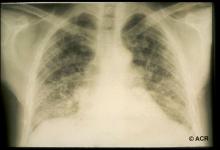Statins in RA Patients Without CVD: Nonsignificant Results Save

Patients with RA, but without CV disease, who were treated with atorvastatin appeared to experience cardiovascular (CV) benefits similar to what has been observed in other populations, with a risk reduction of approximately one-third, according to a large, but prematurely terminated, trial in the U.K.
In a double-blind, placebo-controlled study among RA patients randomized to 40 mg of atorvastatin daily, 1.6% had confirmed CV events during 2.5 years of follow-up, as did 2.4% of those given placebo, for a nonsignificant adjusted hazard ratio of 0.60 (95% CI 0.32-1.15, P=0.127), according to George D. Kitas, MD, PhD, of Russells Hall Hospital in Dudley, England, and colleagues.
However, "the best estimate of the 'true' reduction in CV events in the atorvastatin versus placebo arm is 34%," they reported, based on further analyses that found an additional nonsignificant HR 0.66 (95% CI 0.39-1.11, P=0.115).
Investigators attributed this observed lack of statistical significance to an "unexpectedly low event rate and resulting limited statistical power to detect an effect during the planned 5 years of follow-up, [which] led to premature termination of the trial," they wrote in Arthritis & Rheumatology.
To investigate whether statins may be used in primary prevention of CV disease among RA patients without CV disease, Kitas and colleagues conducted a study at 102 centers that was intended to enroll 5,400 patients, and follow them for 5 years.
However, the low rate of major vascular events led to a loss of power and early termination after the inclusion from 2007 to 2011 of only 3,002 patients in 2.5 years. The predicted annual rate of major events was expected to be 1.6% to 1.8%, which the investigators noted "seemed, if anything, conservative." Yet at the time of study termination, the annual rate of events in the combined groups was only 0.70%.
At baseline, 40.3% of patients had Disease Activity Scores in 28 joints of 3.2 or lower, indicating remission or low disease activity. More than 85% were on conventional disease-modifying antirheumatic drugs, particularly methotrexate; 17% were taking corticosteroids, and 16% were receiving biologics. Importantly, this population did not have CV disease at the beginning of the study.
On the individual components of the composite CV endpoint, rates for the atorvastatin and placebo groups were:
- Nonfatal MI, coronary revascularization, or coronary death: 0.9% vs 1.5%
- Ischemic stroke or transient ischemic attack: 0.4% vs 0.8%
- Non-coronary arterial revascularization: 0.2% vs 0.1%
- Other CV death: 0% for both
- Peripheral atherosclerotic event: 0.1% vs 0%
- Suspected coronary heart disease death: 0.1% for both
Overall, a similar rate of death was seen in the two arms (1.7% vs 1.8%).
The estimated reduction in CV event risk for each 1 mmol/L reduction in LDL cholesterol was 42% (95% CI -14 to 70).
Notably, atorvastatin exerted a statistically significant effect on C-reactive protein (CRP), lowering levels (2.59 vs 3.60, P<0.0001).
Adverse events (AEs) in both groups were similar: a total of 19.8% of patients in the atorvastatin group and 19.5% in the placebo group reported adverse events. For potentially statin- and liver-related AEs, the investigators reported 249 cases of new or significant muscle pain (132 in the atorvastatin group; 117 in the placebo group), which did not differ significantly.
Among patients with muscle pain, nine in the statin group and four in the placebo group had concurrent elevations of alanine transaminase or aspartate transaminase greater than twice the upper limit of normal. These liver function abnormalities were transient and were not considered related to therapy, although two patients in the statin arm and one in the placebo arm were withdrawn from the study.
At the end of follow-up, no differences were seen in measures of RA disease activity, severity, or quality of life, although CRP levels were lower in the statin group (2.59 vs 3.60 mg/L, P<0.0001).
"From a clinical perspective, the safety outcomes are as important as CV event reduction. RA patients typically have multiple comorbidities and polypharmacy, often with potentially hepatotoxic drugs" such as methotrexate, the investigators observed.







If you are a health practitioner, you may Login/Register to comment.
Due to the nature of these comment forums, only health practitioners are allowed to comment at this time.